| |
|
Trinity and Beyond: The Atomic Bomb
Movie |
|
The Incredible History of America's
Development of Nuclear Weapons
Contains Top Secret Atomic Bomb Footage Declassified for this Motion
Picture |
|
"'Trinity and Beyond' is a factually
solid, visually stunning, informative documentary."
Emanuel Levy, Daily Variety
"Seeing a cannon fire a bomb in the Nevada desert or a detonation in
space is enough to recommend this disturbing but explosively
thought-provoking cinematic experience."
David Hunter, Hollywood Reporter |
 |
|
The Top Secret, strange and visually compelling
history of the design, production and testing of Atomic Hydrogen Bombs
Narrated by William Shatner
The Atomic Bomb Movie features an original score performed by the Moscow
Symphony Orchestra
The Atomic Bomb Movie features an interview with Dr.
Edward Teller, the "Father of the Hydrogen Bomb", and one of the most
controversial figures of the 20th century.
This award-winning production also features an amazing explosion segment
that must be seen with 3D glasses to truly take in its full impact.
The Atomic Bomb Movie is an extraordinary production that provides an
important understanding of events, and the creations of technologies,
that have changed the world forever. |
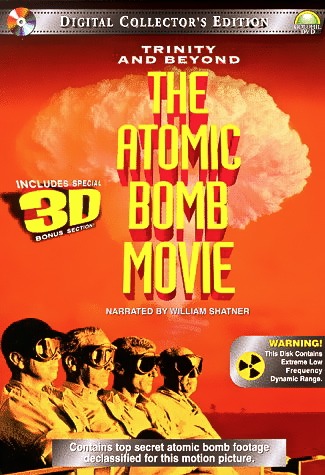 |
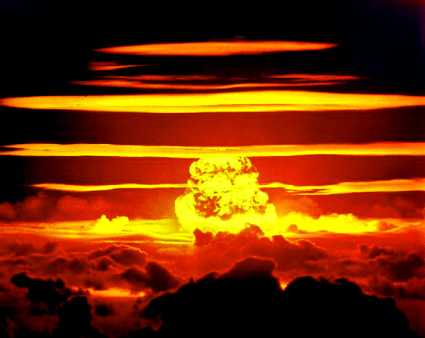 |
The Atomic Bomb Movie features extremely rare film
segments from top secret government archives and startling footage of
nuclear bomb tests conducted by Great Britain and China, plus the
largest atomic explosion ever created, by Russia.
Whether being exploded under the ocean, suspended by a
balloon, shot from a cannon or even detonated in space, these weapons
are capable of devastating destruction - the quality of these images is
as startling as they are remarkable.
Renowned special effects filmmaker Peter Kuran offers up amazing film
footage chronicling this era in human history, during atmospheric
testing of Atomic and Thermonuclear Devices by the United States. The
quality of these images is remarkable and required the development of a
new film restoration system to preserve these haunting images for
generations to come. |
|
Dakota Test (Redwing) |
The Nuclear Battlefield - Below |
|
The M65 280mm Atomic Cannon |
|
The Atomic Cannon, an M65-280mm, is 42 feet long
and weighs 42,500 lbs. It can throw a shell 20 miles |
|
The first atomic cannon went into service in 1952, and
was deactivated in 1963. A single 280mm shell was fired seven miles at
the Nevada Test site on May 25, 1953 as part of the Grable Series -
Upshot/Knothole. The shell detonated 500 feet in the air and yielded a 15
kiloton explosion
(there's an amazing government film of the cannon
firing and the mushroom cloud footage, included in the Atomic Bomb
Movie).
Twenty Atomic Cannon were manufactured; at least 8 appear to have
survived the Cold War and are on public display today. The largest
atomic cannon sits in a public park in Junction City, Kansas, on loan
(permanent) from the Smithsonian. You can find the others at:
Yuma Proving Ground, Yuma, Arizona
Rock Island Arsenal, Memorial Field, Rock Island, Illinois
Atomic Museum, Albuquerque, New Mexico
Fort Sill Museum, Oklahoma
Virginia War Memorial Museum, Newport News, Virginia
Watervliet Arsenal, Watervliet, NY -- where they were all manufactured |
|
The Popularity of the Atomic Cannon in the 1950's -
Below Examples of Children's Models |
|
Hiroshima - 69 Years After Zero Hour |
|
On August 6, 1945 the United States
dropped “Little Boy" at Hiroshima
The first of only two nuclear bombs ever used in warfare
|
|
The bomb was dropped from an American B-29
Superfortress, known as Enola Gay, at 0815 local time
The plane's crew say they saw a column of smoke rising and intense fires
springing up |
| President
Truman, "If they do not now accept our terms they may expect a rain of
ruin from the air the like of which has never been seen on Earth. Behind
this air attack will follow by sea and land forces in such number and
power as they have not yet seen, but with fighting skill of which they
are already aware." President Truman, announcing the
Hiroshima news from the cruiser, USS
Augusta, in the mid-Atlantic, said the device was more than 2,000 times
more powerful than the largest bomb used to date.
Hiroshima, was the 'success' of Little Boy, a simple atomic bomb. On day
four, Nagasaki experienced the technological triumph of Fat Man, a more
sophisticated design. Five days later came what the official Air Force
history calls the “grand finale,” a 1,000-plane raid (no mean
logistical achievement) attacking Japan’s cities and killing many
thousands of people, with leaflets falling among the bombs reading
“Japan has surrendered”. |
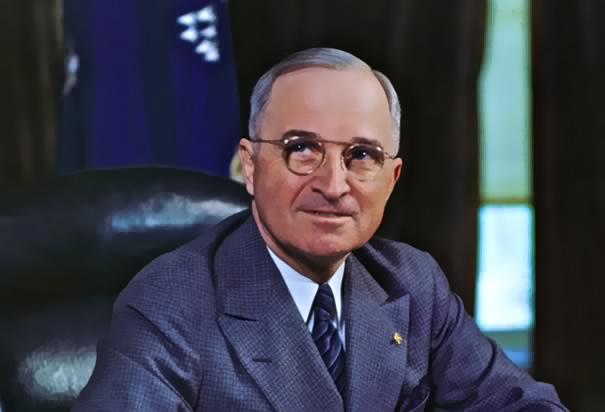 |
|
Hiroshima before the Atom Bomb |
| The Hiroshima bomb, known as "Little Boy" devastated an area of five
square miles. More than 60% of the buildings in the city were destroyed.
Official Japanese figures at the time put the death toll at 118,661
civilians. But later estimates suggest the final toll was about 140,000,
of Hiroshima's 350,000 population, including military personnel and
those who died later from radiation. Many have also suffered long-term
sickness and disability. |
|
Crew of the Enola Gay (B29 Aircraft
that Dropped the Hiroshima Atom Bomb) |
|
|
The plane’s navigator and last surviving member of
the crew, Theodore Van Kirk, died just a week before the 69th
anniversary of Hiroshima, at the age of 93.
Before his death, Van Kirk told the Associated Press that while the
mission went perfectly, and that he believed the bombing which killed
some 140,000 people actually saved lives in the long run, he felt
slightly conflicted.
“I personally think there shouldn't be any atomic bombs in the world
— I'd like to see them all abolished,” Van Kirk said. |
|
Hiroshima - Cherry Blossoms Today |
|
Bikini Marshal Islands Pacific Atoll
- Operation Crossroads |
|
In July 1946 on Bikini Atoll, the
United States tests two Atomic Bombs - code named "Operation Crossroads"
These were the fourth and fifth atomic bombs ever
detonated on Earth |
|
“An outstanding achievement on all
levels… an extraordinarily perceptive, haunting and informative
documentary. It presents itself with quiet conviction but its
under-lying passion burns in our minds and souls… an enviable artistic
contribution.”
- Los Angeles Times
“A remarkable documentary collage… The awesome beauty of the
explosions."
- London Times |
 |
|
The Most Terrifying and Unbelievable
Story of the Nuclear Age
Radio Bikini is an internationally acclaimed,
award-winning (and Oscar nominated) documentary film about an operation
to test nuclear weapons conducted by the United States. Staged at a
remote Pacific atoll called Bikini in the summer of 1946, the tests
(Operation Crossroads) were also one of the first great ‘media events’
of the modern age.
Using rare and mostly never-before-seen archival footage, the film
unfolds through the eyes of the elderly chief of the Bikinians, Kilon
Bauno, and a former American serviceman, John Smitherman, who was there.
Radio Bikini combines ‘live’ radio broadcasts from Bikini in 1946 with
footage of the entire operation, recreating a feeling of the event as it
happened in a way that is both haunting and surreal.
As the drama of this bizarre experiment unfolds, we witness glimpses of
the U.S. Government’s never-completed attempt to produce a propaganda
film about it. Ultimately, Radio Bikini is an allegorical
portrait of a naive world at the dawn of a new era. |
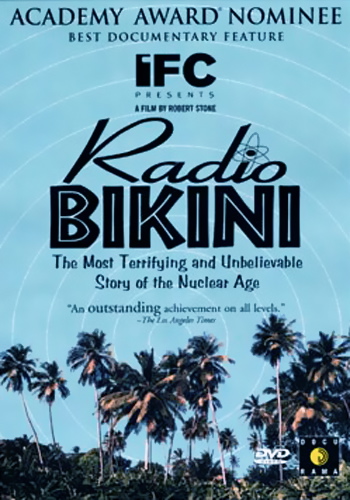 |
|
Produced by British film maker Robert Stone
|
1988 (Color and B&W) 56 minutes |
| This documentary is an outstanding achievement on all levels. Stone
conveys an enormous body of facts, figures, attitudes and effects in the
most organically subtle fashion.
Delving into historic archives, Stone has unearthed some sobering,
formerly classified material that serves as the body of Radio Bikini. The U.S. government spared no expense to capture every
possible second from every conceivable angle (apparently half the
world's supply of film stock was consigned for it) of what was to be the
definitive propaganda film of the era. It was never made but footage
wound up in the newsreels. Now, more than 40 years later, the it is used
for a purpose contrary to its original intent. |
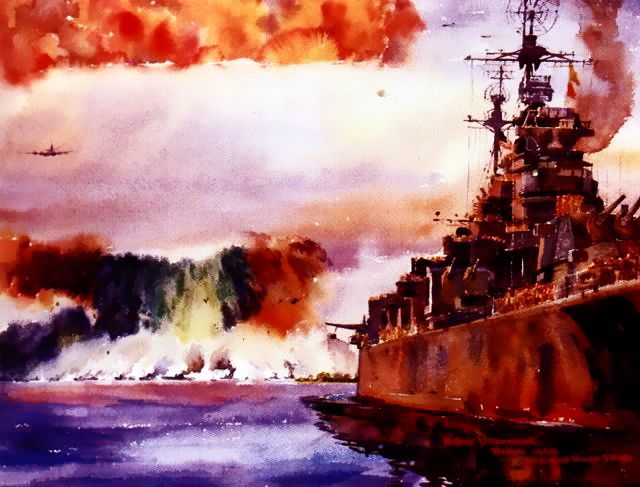 |
In 1946, the United States, fresh from victory in the Pacific,
staged two nuclear explosions near the remote Pacific island of Bikini.
It was the first attempt at scientifically analyzing the effects of
nuclear weaponry. The resonant fallout from the experiments form the
basis of Radio Bikini, an extraordinarily perceptive, haunting
and informative documentary.
Operation Crossroads, the code name assigned the experiment, was
anything but covert. About 42,000 servicemen and observers were on hand
for the two July detonations that were filmed and broadcast throughout
the world. It was a demonstration of American might and a huge media
event to foster the idea of the U.S. as responsible and concerned
guardians of this powerful new device.
In hindsight, Crossroads was the most chilling experiment of all time.
Apparently there was a belief in 1946 that you could reason with
radioactivity, in sharp contrast to the expectations of officials who
anticipated something apocalyptic. |
| The sentiment at home was overwhelmingly gung-ho for the operation,
though the incident also attracted the first anti-nuke demonstrators
(footage Stone also incorporates). One of their placards reads: "Wrong
Road to Peace," and it's these jarring images and the inflection of "we
leave this to the judgment of history" and other official words of
rationalization that echo all the way to the present. |
Radio Bikini is one of those clever documentary projects that
means to tell its tale almost exclusively through the footage and voices
of those involved in the incident as it happened. There are only two
staged interviews in the entire film; the rest of the imagery and
narrative comes directly from military and newspaper archives, voices
and scenes combined and compiled out of existing material to make it the
event telling the story.
It is, thankfully, through the work of filmmaker Robert Stone that we
can finally see the Bikini island tests for what they really were.
Radio Bikini makes the point clearly and often that America was
scared after World War II: afraid that its power could be instantly
usurped once another nation got the bomb and used it; afraid that
Nagasaki and Hiroshima was not enough to dissuade enemies. And mostly
afraid that, in a couple of devastating demonstrations of mankind's
manipulation of the atom, the age old ways of making war and defending
one's nation had become obsolete.
So the Bikini tests were meant to prove that soldier and earth scorcher
could co-exist, that even after immense explosions of heat, force, and
radiation, with metal twisted and test animals obliterated, human beings
could enter Ground Zero and casually assess the damage (and by
extrapolation, continue fighting the rest of the war). Unfortunately,
the thickheaded naďveté of such a supposition resulted in hundreds of
lives being lost or forever changed (even at the biological level) as
direct contact with radioactive water and material meant a quicker death
for those unfortunate fellows following orders. Radio Bikini is a
eulogy for everyone and everything that was lost during those dark days
of 1946. The world has never really fully recuperated. |
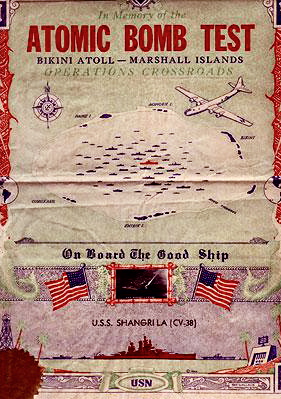 |
|
The Bikini Atoll in the Marshall
Islands is picked as the Location for Two Tests
An Airburst Bomb and an Underwater Explosion
Hundreds of military men, scientists, soldiers, and
journalists travel to the remote paradise to witness the destructive
power of nuclear energy |
| There were two big obstacles, however. There were the Bikini
Islanders, who were relocated to neighboring islands. Then there was the
issue of recording the tests. Again, the US military rises to the
challenge and collects 750 cameras, half the world's supply of film, and
several hundred soldiers to act as "location managers". As the testing
begins and the bombs burst above and below, the soldiers sit back and
assess the damage—even as the fallout settles all around them. |
|
USS Saratoga Aircraft Carrier
The Saratoga had it's bottom blown out by the underwater Baker Test
It sits on the bottom of Bikini Lagoon to this day |
Test Able atomic bomb was dropped from
the B-29 Superfortress "Dave's Dream" and detonated at an altitude of
158 meters at 9am, on July 1st, 1946. This airburst was meant to
duplicate the conditions of the Hiroshima bomb drop, but this time over
water. The bomb missed the target ship, the USS Nevada (BB-36)
battleship, by 650 meters.
The ships sunk by this blast included: the USS Gilliam and USS Carlisle
attack transports which sank immediately; the USS Anderson and USS
Lamson destroyers which sank within hours of the blast; and the Japanese
IJN Sakawa light cruiser which sank the following day. A further 14
ships sustained serious damage.
Test Baker atomic bomb was detonated 27
meters underwater beneath the landing craft LSM-60 on July 25th, 1946.
The ships sunk by this blast included: LSM-60 amphibious (no
identifiable part of LSM-60 was ever found and it was presumed vaporized
by the nuclear fireball), USS Arkansas battleship, USS Pilotfish
submarine, USS Saratoga aircraft carrier, YO-160 yard oiler, HIJMS
Nagato battleship, USS Skipjack submarine, USS Apogon submarine, and
ARDC-13 dry-dock. |
|
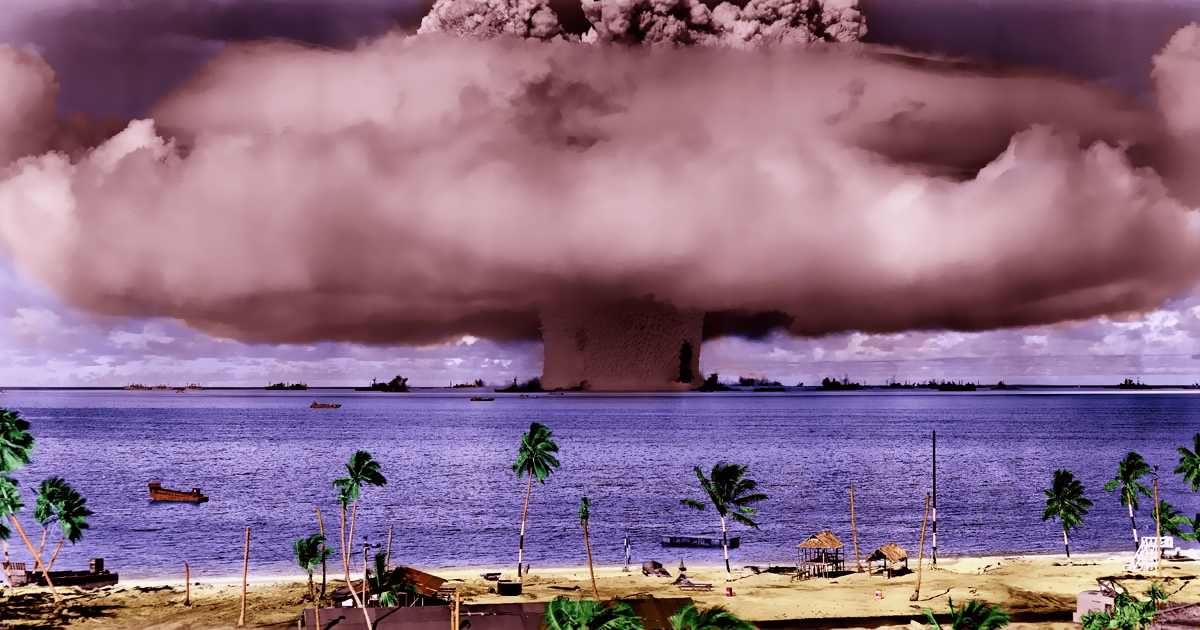 |
|
Underwater Test Baker - Bikini Atoll |
|
Bikini Island is still too radioactive to sustain
human and plant life! |
|
Islanders Afraid to go Home - 60
years after Bikini Atoll H-bomb
Basic distrust of United States persists, 6 decades after
1954 Hydrogen Bomb Test
The World Heritage Committee, on August 1, 2010 at
its 34th session in Brazil, inscribed the Bikini Atoll Nuclear Test Site
on the World Heritage List |
|
The Marshall Islands marked 60 years since the devastating US
hydrogen bomb test at Bikini Atoll, with angry exiled residents saying
they were too fearful to ever go home! |
|
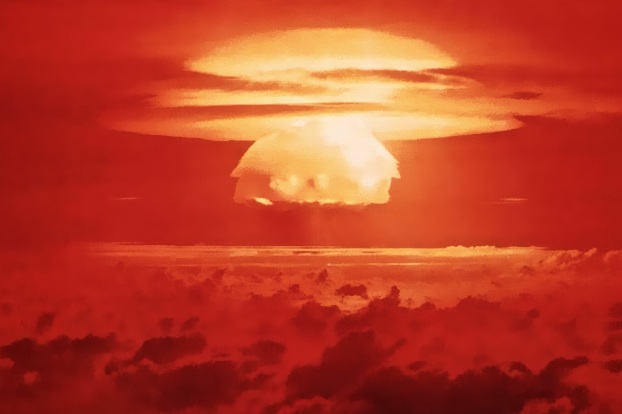 |
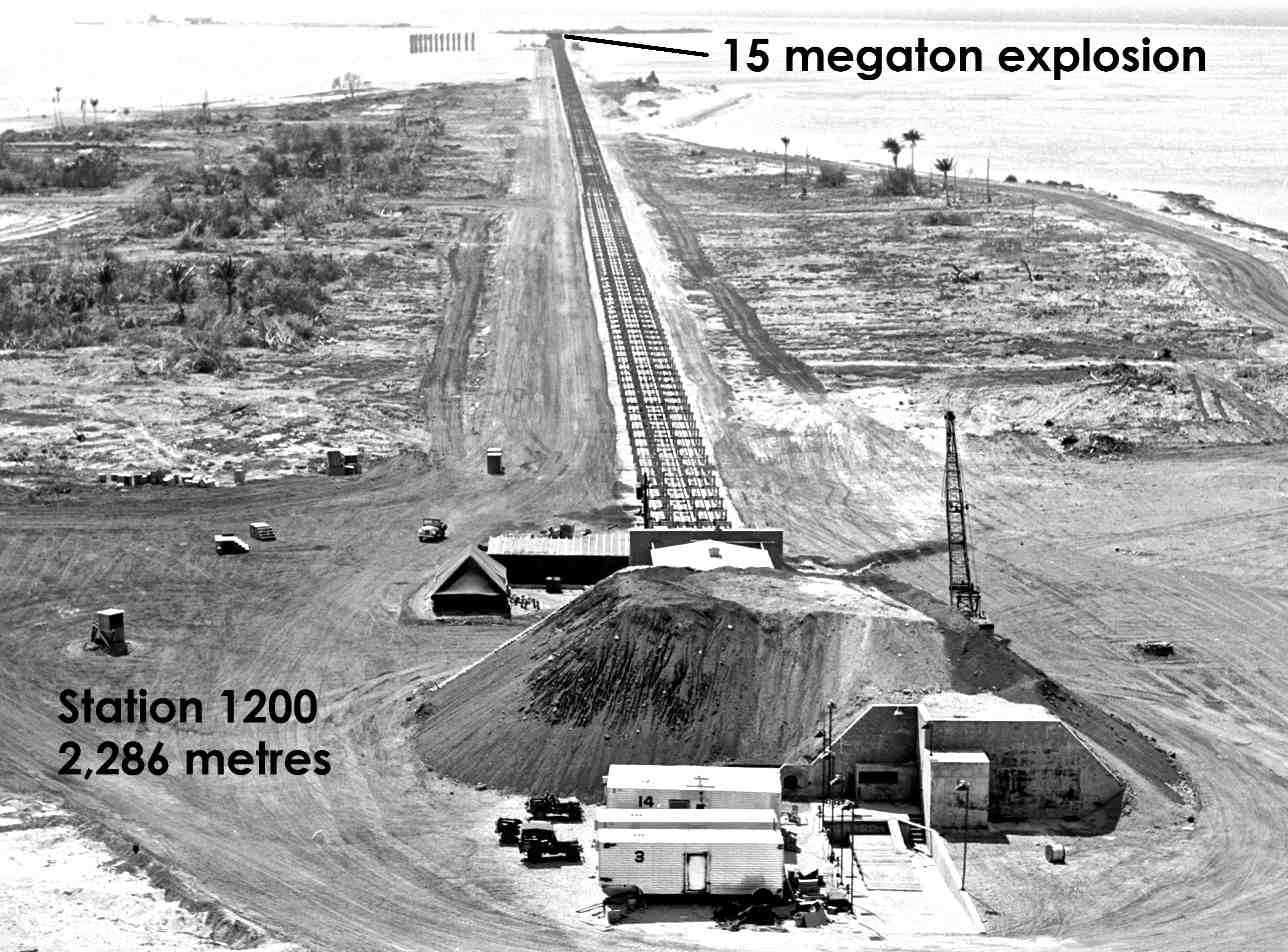 |
|
15-megaton "Bravo" Hydrogen Bomb -
March 1st, 1954 |
Castle Bravo - Automatic
Scientific
Instrumentation Facilities |
Part of the intense Cold War
nuclear arms race, Bravo test was 1000 times more powerful
than the atomic bomb dropped on Hiroshima.
It vaporized one island and exposed thousands in the surrounding area to
radioactive fallout. |
As those who remembered that terrifying day gathered in the Marshall
Islands' capital of Majuro, along with younger generations, to
commemorate the anniversary, many exiles refused to go back to the zones
that were contaminated, despite United States safety assurances.
"I won't move there," Evelyn Ralpho-Jeadrik, 33, said of her home atoll,
Rongelap, which was engulfed in a snowstorm of fallout from Bravo and
evacuated two days after the test. "I do not believe it's safe and I
don't want to put my children at risk." |
|
Rongelap Atoll Demonstration |
People returned to live on Rongelap in 1957 but fled again in 1985
amid fears, later proved correct, about residual radiation.
One of the more than 60 islands in Rongelap has been cleaned up as part
of a United States-funded $45 million program, but Ralpho-Jeadrik said she has no
intention of going back.
"I will be forever fearful. The United States told my mother it was safe
and they returned to Rongelap only to be contaminated again," she said. |
|
New York Times_1946 |
Bikini Atoll Map |
King Juda & Wife_1946 |
It is not just their homes which have been lost, said Lani Kramer,
42, a councilwoman in Bikini's local government, but an entire swathe of
the islands' culture. "As a result of being displaced, we've lost our
cultural heritage -- our traditional customs and skills, which for
thousands of years were passed down from generation to generation," she
said.
Bikini islanders have lived in exile since they were moved for the first
weapons tests in 1946, when Kramer's own grandparents were evacuated.
When United States government scientists declared Bikini safe for resettlement,
some residents were allowed to return in the early 1970s. But they were
removed again in 1978 after ingesting high levels of radiation from
eating local foods grown on the former nuclear test site.
"After they were exposed like that I can never trust what the United
States tells
us," said Kramer, adding that she wants justice for the
generations forced to leave. |
|
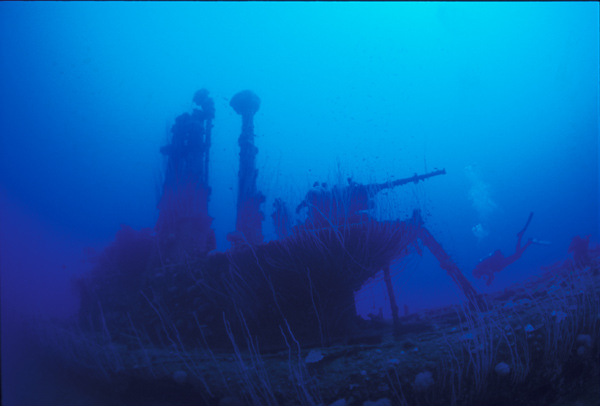 |
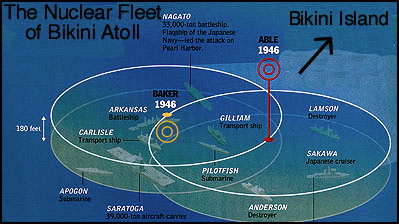 |
|
USS Apogon Submarine |
Operation Crossroads - Nuclear Test Fleet |
The Marshall Islands Nuclear Claims Tribunal had awarded more than
$2 billion in personal injury and land damage claims arising form the
nuclear tests, but stopped paying after a United States-provided $150
million compensation fund was exhausted.
At a ceremony to mark the anniversary, Marshall Islands President
Christopher Loeak called on the United States to resolve the "unfinished
business" of its nuclear testing legacy, saying compensation provided by
Washington "does not provide a fair and just settlement" for the damage
caused.
The United States embassy in Majuro said on its website: "While
international scientists did study the effects of that accident on the
human population unintentionally affected, the United States never
intended for Marshallese to be hurt by the tests." |
Attending the week-long commemorations is 80-year-old Matashichi
Oishi -- one of 23 fishermen aboard the Japanese Lucky Dragon boat,
which was 100 kilometres (60 miles) from the bomb when the test
occurred.
"I remember the brilliant flash in the west, the frightening sound that
followed, and the extraordinary sky which turned red as far as I could
see," he said.
The plight of the crew is well-known in Japan and on Saturday nearly
2,000 people marched to the grave of Aikichi Kuboyama -- the chief
radioman of the boat -- in the port city of Yaizu, 170 kilometres
southwest of Tokyo, to mark the anniversary. |
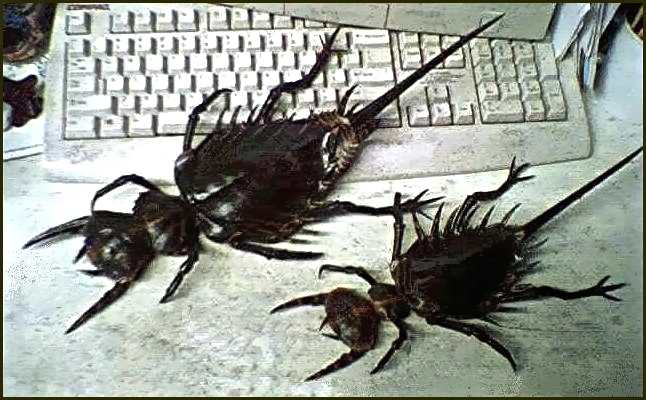 |
| Kuboyama died of acute organ malfunction nearly seven months after
the test, while 15 other crew members later died of cancer and other
causes. |
Giant Tailed Stag Beetles_Bikini Atoll |
United States nuclear experiments in the Marshall Islands ended in
1958 after 67 tests. But a United Nations report in 2012 said the
effects were long-lasting. Special Rapporteur Calin Georgescu, in a
report to the UN Human Rights Council, said "near-irreversible
environmental contamination" had led to the loss of livelihoods and many
people continued to experience "indefinite displacement".
The report called for the United States to provide extra compensation to
settle claims by nuclear-affected Marshall islanders and end a "legacy
of distrust". |
|
Marshall Islands Sues over Nuclear
Arms
The Marshall Islands was the site of Devastating
Nuclear Tests in the mid-20th Century
The tiny Marshall Islands is dragging the United States and eight other
nuclear-armed countries to the UN's highest court for failing to halt
the nuclear arms race and rid the world of atomic weapons |
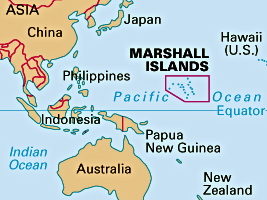 |
| Representatives of the Marshall Islands, site of devastating nuclear
tests in the mid-20th century, filed... separate applications against
nine states, the Hague-based International Court of Justice said in a
statement. China, North Korea, France, India, Israel, Pakistan,
Russia, Britain and the United States are accused of "not fulfilling
their obligations with respect to the cessation of the nuclear arms race
at an early date and to nuclear disarmament." The government based in
the Marshall Islands capital of Majuro said by not stopping the nuclear
arms race, the countries continued to breach their obligations under the
Nuclear Non-Proliferation Treaty (NPT) -- even if the treaty has not
been by signed by some like India and Pakistan. |
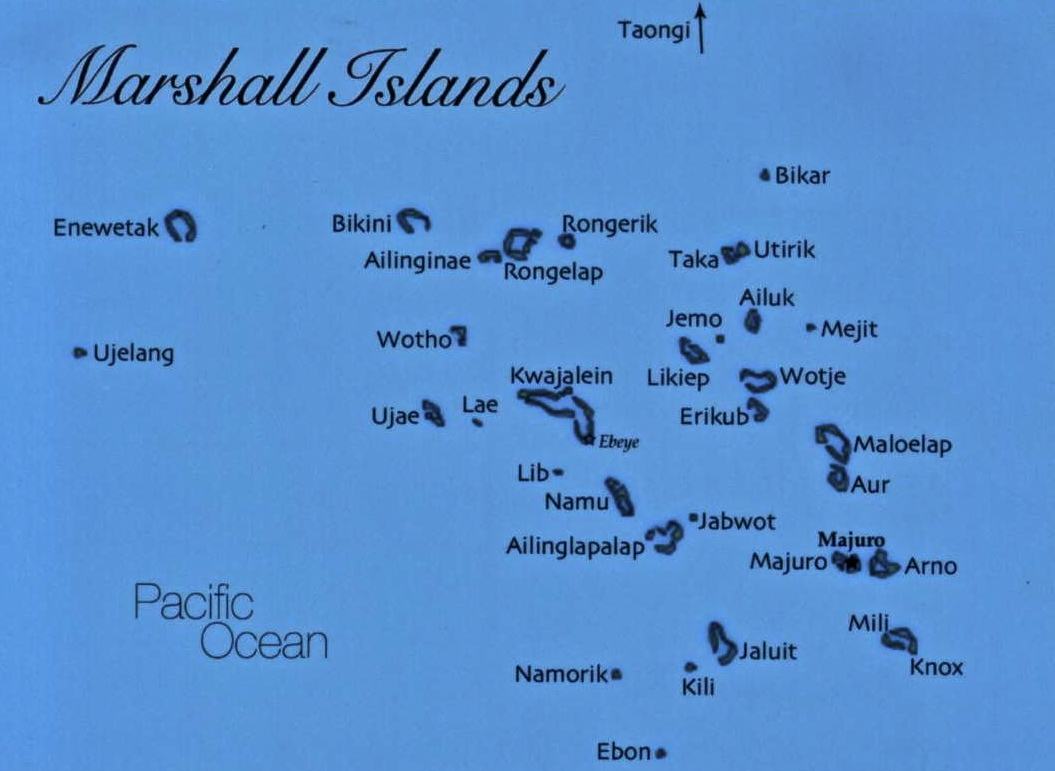 |
The Marshall islands also included Israel, widely believed to be the
sole -- if undeclared -- nuclear armed power in the Middle East.
Majuro's representatives said the Marshall Islands decided to sue the
world's nuclear heavyweights as "it has a particular awareness of the
dire consequences of nuclear weapons." Last month the Marshall Islands
marked 60 years since the devastating hydrogen bomb test at Bikini
Atoll, that vapourised an island and exposed thousands in the
surrounding area to radioactive fallout.
The 15-megaton test on March 1, 1954, was part of the intense Cold War
nuclear arms race and a thousand times more powerful than the atomic
bomb dropped on Hiroshima.
The United States conducted repeated tests between 1946 and 1958 in the
Marshall Islands, Majuro's representatives said in papers filed in
court. |
"During those 12 years, 67 nuclear weapons of varying explosive
power were detonated in the Marshall Islands, at varying distances from
the human population." Bikini Islanders have lived in exile since they
were moved for the first weapons tests in 1946.
When US government scientists declared Bikini safe for resettlement,
some residents were allowed to return in the early 1970s. But they were
removed again in 1978 after ingesting high levels of radiation from
eating local foods grown on the former test site.
The Marshall Islands Nuclear Claims Tribunal had awarded more than 2
billion ($2.15 billion) in personal injury and land damage claims
arising form the nuclear tests, but stopped paying after a $US150
million US compensation fund was exhausted.
Last month Marshall Islands President Christopher Loeak called on the US
to resolve the "unfinished business" of its nuclear testing legacy,
saying compensation provided by Washington "does not provide a fair and
just settlement" for the damage caused. |
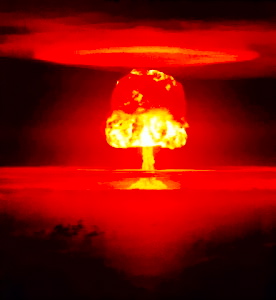 |
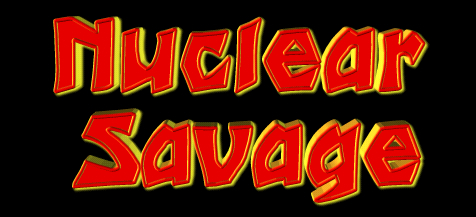 |
|
The United States “destroyed an entire country that
we were not at war with, that we were at peace with. Not only did they
blow up these islands, but they contaminated all these people. It’s a
very unknown story here.” |
 |
|
As early as 1956, the Atomic Energy
Commission had characterized the Marshall Islands as:
“By far the most contaminated place in the world” |
|
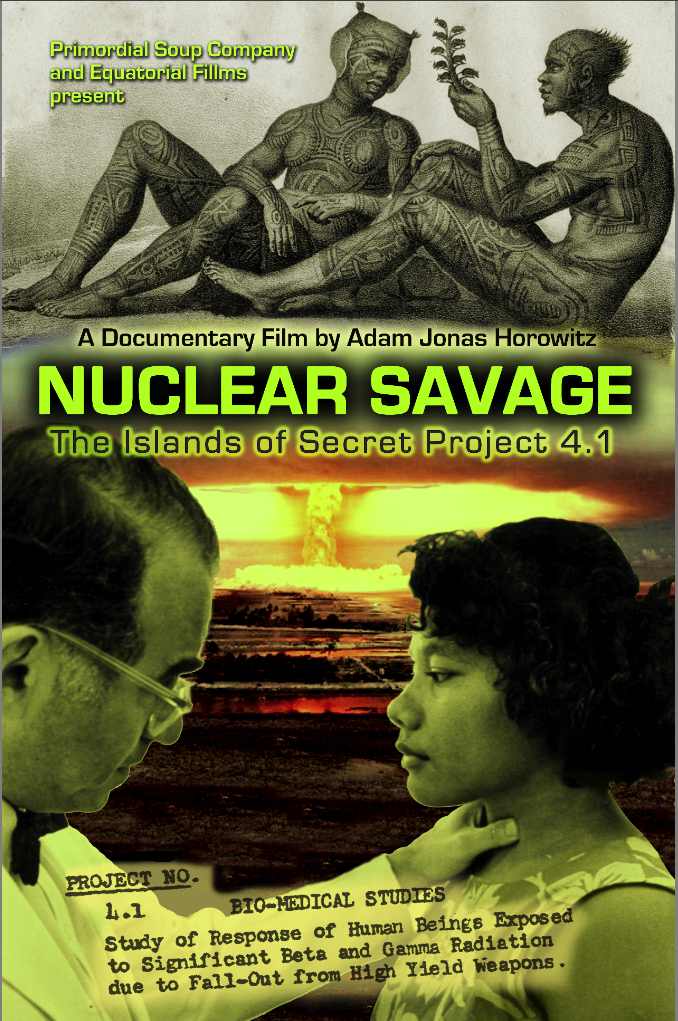 |
Filmmaker Adam Jonas Horowitz spent 25 years collecting material, including original footage, archival clips, and unpublished secret
documents, to create this unforgettable and ironic portrait of American
cynicism, arrogance, and racism. Winner of festival awards in Paris,
Chicago and Mexico City.
Nuclear Savage
is a heartbreaking and intimate ethnographic portrait of Pacific
Islanders struggling for dignity and survival after decades of radiation
poisoning at the hands of the American military. Radioactive coconuts,
leaking nuclear waste repositories, and densely populated slums were all
the direct result of 67 Cold War U.S. atomic and hydrogen bomb tests
that vaporized islands and devastated entire populations.
“Nuclear Savage” is a recent documentary film that
explores American nuclear weapons testing in the Marshall Islands,
1946-1958, and particularly the secret Project 4.1: an American
experiment in exposing Pacific Islanders to overdoses of radiation, deliberate human radiation poisoning, just to get better data on this
method of maiming and killing people. The public broadcasting
establishment has spent more that two years keeping this story off the
air.
The term “savage” is used to refer to people from primitive cultures,
but this documentary shows how savagery reaches new levels with the
advent of advanced technology. In the 1950s, the U.S. conducted 67
nuclear tests in the Marshall Islands, vaporizing islands and exposing
entire populations to fallout. The people of Rongelap received near
fatal doses of radiation from one of these tests, and were then moved to
a highly contaminated island to serve as guinea pigs to test the affects
of radiation on humans for almost 30 years, where they suffered from
recurring cancers and birth defects that have affected multiple
generations. This cynical act by the U.S. government was conducted with
such arrogant racism that without incredible archival footage and
shocking secret documents, the story would seem to be unbelievable. |
In 1946, the U.S. evacuated the entire population of Bikini Atoll
(167 people) and logged the first of 23 atomic weapons explosions that
have made what’s left of the atoll (part of it was vaporized) a largely
uninhabitable radioactive tourist destination [one report says 4-6
“caretakers” live there]. Most of the 167 original residents have died,
but their descendants number more than 4,000. A 1975 federal lawsuit
(seeking roughly $750 million in compensation promised but not paid by
the U.S.) was denied review by the U.S. Supreme Court in April 2010, but
the effort to make the U.S. provide just compensation continues.
In 1947, the United Nations included the Marshall Islands in a Trust
Territory controlled by the U.S., whose obligations included the duty to
“protect the inhabitants against the loss of their lands and resources.”
Later in the year the U.S. evacuated the entire population of Enewetak
Atoll, where it would explode another 44 atomic weapons, the last series
in 1958. |
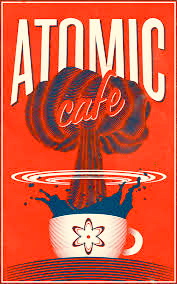 |
 |
|
The Atomic Cafe Documentary Film
Footage (1982) |
|
Nuclear Insanity at the Birth of the
Atomic Age
The Goldmine of Absurdity |
|
If this movie has a message beyond
its obvious one (that nuclear war will be devastating and our civil
defenses pathetic) it is a rather more subtle one. It acts as a reminder
that, in the 1950s the government at least spent a good deal of its
resources on addressing the possibility of nuclear war, however
uselessly. Today, the government maintains a discreet silence about this
awesome and awful subject. |
|
The Atomic Cafe is a chilling memory of life in the first
years under the mushroom umbrella. There was a brief national euphoria
after Hiroshima and Nagasaki (because America had the atomic bomb, so
there would never have to be another war). But soon the Russians had the
bomb, too, and since they were godless communists, it was obviously only
a matter of time until war broke out. |
 |
|
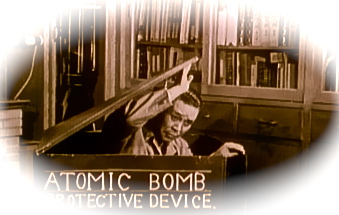
The makers of The Atomic Cafe sifted through thousands of
feet of Army films, newsreels, government propaganda films and old
television broadcasts to come up with the material in their film, which
is presented without any narration, as a record of some of the ways in
which the bomb entered American folklore. There are songs, speeches,
politicians, and frightening documentary footage of guinea-pig American
troops shielding themselves from an atomic blast and then exposing
themselves to radiation neither they nor their officers understood.
''One of the most beautiful sights ever seen by man'' is the way one
enthusiastic United States Army chaplain describes the detonation of an
atomic bomb, an event about to be witnessed for the first time by his
men in the Nevada desert.
The Atomic Cafe focuses on the late 40's and early 50's, but it
could not be more timely. It provides some background for nuclear-war
optimism today. |
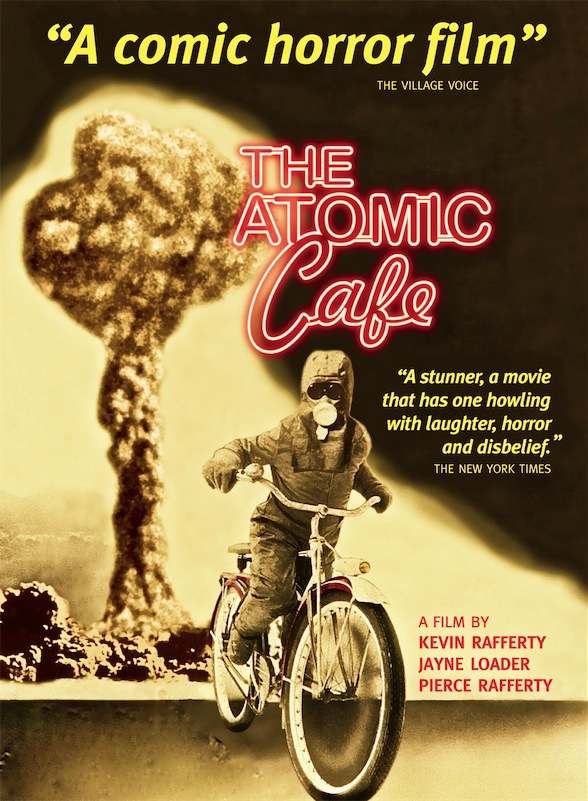 |
| The unprovable assumption that nuclear wars can be fought on a
limited scale without making the planet uninhabitable. |
Produced and Directed by Kevin
Rafferty, Music Coordinator Rick Eaker, Distributed by the Archives
Project Inc, Running Time: 88 minutes |
|
Even if the Detonation of an A-bomb is one of the
Most Beautiful sights ever seen by Man
It may also be Man's last sight of Anything |
|
One of the few public figures who seems to take the
peril seriously in The Atomic Cafe is President Dwight D.
Eisenhower, shown in a clip of a speech in which he stresses that
science has ''outrun'' our social, political and intellectual
institutions. |
The Atomic Cafe proceeds in generally
chronological order, beginning with the first successful Atomic Test
(Trinity) at Alamogordo, New Mexico, and goes on to include President
Harry S Truman's triumphant announcement of the atomic bombing of
Hiroshima, when he pledges that the weapon will be used ''in His ways
and to His purposes''. After the war, the US prepares to test more
atomic devices on islands in the Bikini Atoll. We witness the United
States Navy relocating ''the friendly natives'' of Bikini in
preparation. In the late 1940s, as the Cold War begins to escalate and
the USSR develops nuclear weapons of its own, fear begins to spread
about a potential Third World War that would be fought with such
weapons. Watch a Government training film and see members of a happy,
middle-class American family repairing to their bomb shelter fitted with
a periscope. Then, as the conflict in North Korea grows, officials like
Senator Lloyd Bensen come out in favor of using nuclear weapons against
the Chinese.
On the soundtrack we hear ''Atomic Power'' by the Buchanan Brothers,
''Uranium'' by the Commodores, ''Atomic Love'' by Little Caesar, plus
other rock-and-roll, blues, country and gospel numbers that were the way
this nation's music industry responded to the dawn of the atomic era in
the late 1940's and 50's. |
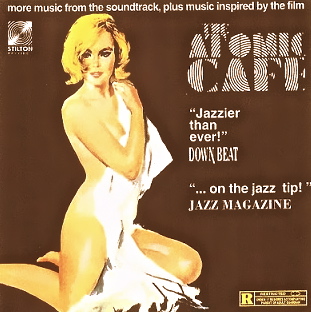 |
| The most heartbreaking scenes in the movie show grade and
high-school students participating in civil defense programs. Two school
girls proudly, if self-consciously, display the bomb-shelter provisions
they made in their home-economics class: a dozen one-quart Mason jars
filled with dehydrated potatoes, dehydrated milk, vegetables and dried
fruit. But it is clear from their faces that they have no clue of how
they would survive nuclear war, and little hope of doing so. Kids are
lectured by authority figures in shots from educational films, but it
must hardly have been reassuring to learn of your "chances" in a nuclear
war. Burt the Turtle, a cheerful cartoon character in a training film
for children, demonstrates how he ducks and safely covers himself inside
his shell whenever a firecracker explodes nearby - in this way to train
children to crawl under their desks and hide their eyes as soon as they
see the bright light of an Atom Bomb Detonation.
When changing winds blows radiation from a test toward a nearby town,
residents are told to stay inside for an hour and not worry. And the
list goes on. But, in one of the few examples of antinuclear footage
used, spokesmen from Columbia University counter a government statement
that people more than 12 miles from the center of a blast will be safe
by noting that the firestorm would cover 2000 square miles, incinerating
anyone in a fallout shelter in that area. |
|
The Atomic Cafe proves that Authoritative,
Official-looking Speakers don't always know what they're talking about!
Incidentally, the United States Postal Service had plans
to issue emergency change-of-address cards in case of an all-out nuclear
attack. |
| One gets the impression from all of these propaganda films that we
should anticipate nuclear war as inconvenient but fun, like being snowed
in on the farm for a weekend. Why should 85 percent of the population
worry about the bomb one spokesman asks, when only 15 percent of the
population would be killed in it? Or, to paraphrase the philosophy
expressed in song in a Walt Disney film, ''Nothing is so awful that
wishing won't make it seem not so bad.'' |
|
"Atomic Cafe"
Has been a popular name for Nightclubs and Coffee Houses |
|
Nuclear War barely Averted in 1983 |
|
Stanislav Petrov served at a Command Center of the
Soviet Missile Early Warning System outside Moscow
Command Center received reported launch data of five Nuclear
Missiles, from United States Territory, on September 26, 1983
Petrov prevented a Nuclear War from being triggered, by Trusting his
Judgment, and Ignoring his Direct Responsibilities |
|
Deep inside Serpukhov-15, a secret bunker
somewhere in the Soviet Union, military officers regularly monitored the
early warning satellites. On September 26, 1983, Serpukhov-15 rotated
its officers, putting Lt. Colonel Stanislav Petrov in charge of
the Ballistic Missile Early Warning System command and control
post.
In the early hours of that morning, the Soviet Union's
satellite system detected an incoming missile strike from the United
States. The alarms sounding in Serpukhov-15 were deafening. Lt. Col.
Petrov stood watching a red button flashing “Start” in bright lettering.
Time was running out. Computer readouts suggested several missiles had
been launched. The protocol for the Soviet military would have been to
retaliate with a nuclear attack of its own.
If war had come, Soviet missiles would have destroyed Britain entirely,
at least half of Germany and France, and America would have lost maybe
30 percent of its cities and infrastructure. |
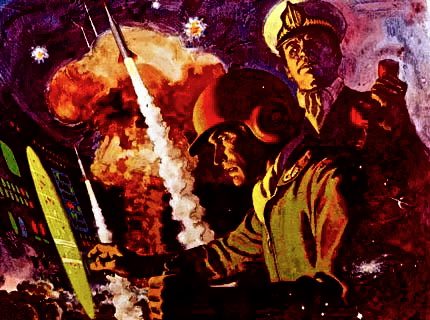 |
| That estimate is only for the one side’s destruction; the detection
of a Soviet launch by US satellites would have elicited an immediate,
devastating response from the Pentagon. |
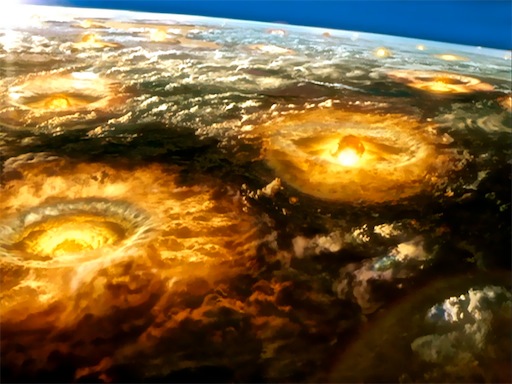 |
Petrov’s duty was to report the incoming missiles to his superiors,
who were likely to order a snap retaliatory strike. However, he chose to
ignore the report, ruling it an equipment malfunction and reckoning five
missiles insufficient for a proper war.
His guess was right: an investigation proved the warning to be a false
report by a monitoring satellite confused by sunlight reflecting off
high-altitude clouds."This is the closest we’ve come to accidental
nuclear war,” noted the director of the US Center for Defense
Information, concerning the September 26th incident. A quickly
escalating nuclear exchange could very well have emptied or destroyed
each side’s remaining arsenals. |
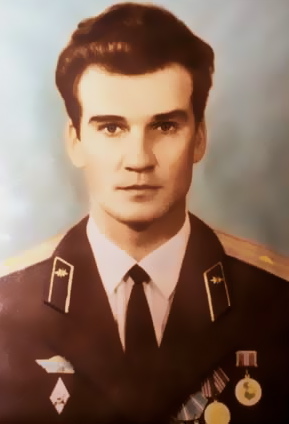 |
| |
|
Lt. Colonel Stanislav Petrov |
|
 |
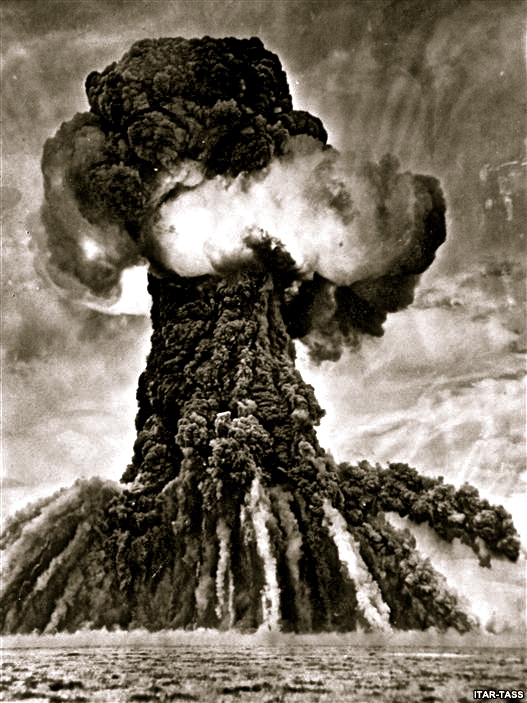
On August 29, 1949 at 7 am, the first Soviet nuclear bomb -- named
First Lightning -- exploded in the steppe of eastern Kazakhstan,
throwing up a huge mushroom cloud and dumping vast amounts of
radioactive materials on the 1.5 million people living in the nuclear
impact zone, which is the size of Belgium. |
Kazakhstan Reels from Impact of Nuclear Tests, 20 Years On
The provincial and otherwise unremarkable town of Semey, whose name
was changed four years ago, lies 150 kilometres (93 miles) west of the
18,400 square-kilometre (7,100 square-mile) nuclear testing site where
the arms race between the Soviet Union and the United States began.
Although the site has been shut down for 20 years, Kazakhstan is
still reeling from the effects of long-term nuclear testing. The
Semipalatinsk region around the test site was subjected to the fallout
from a total of 616 nuclear explosions over a period of 40 years.
The contamination at the site is scattered and levels have not changed
significantly in the last 20 years.
Sitting in her tiny room at a home for the elderly in the eastern
Kazakh city of Semey, Matushkina remembers the days when the loud blasts
of nuclear tests several hundred kilometres away frightened everyone.
Almost every day, announcements on the radio at noon would say: 'Now
there is going to be a test of nuclear weapons.' Everything would shake.
The windows in my classroom were shattered by the shockwave from one of
the blasts," Matushkina said.
Ahead of nuclear tests, the Soviet military warned the public to shut
windows and stay at home or remain inside buildings, witnesses recall.
But one of those who decided to peep out of curiosity was Suakysh
Iskakova, 77, a resident at the same home as Matushkina, who says she
paid for it with her eye-sight. "When I was blinded from the blast, my
uncle took me to see the doctor and the doctor said it was my own fault
that I looked at the bright light from the explosion," Iskakova said. |
|